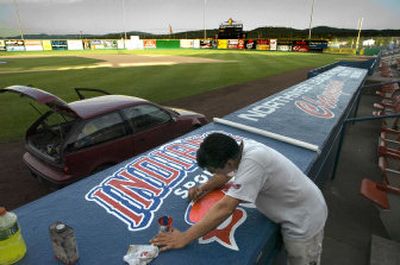Painter a hit at ballpark

Someone once told sign painter Ruben Marcilla to hold on to the Walkman he listens to daily so he eventually can put it in a museum.
In an era that is moving full force into digital technology, Marcilla refuses to move with it and remains old-school when it comes to his entertainment – and his profession.
At Avista Stadium, home of the Spokane Indians, it’s hard to miss Marcilla’s handiwork. The ballpark is decorated with signs, advertisements and logos, and Marcilla, 49, has hand-painted nearly all of them.
That is why Otto Klein, senior vice president of the Indians, calls Marcilla an artist.
“The clear distinction with Ruben is that he’s a sign artist,” said Klein, who has worked with Marcilla for 14 years. “He’s not just a sign painter – he creates things.”
Marcilla enters the stadium after sundown, sets up a transparency projector on the field and projects an image onto the outfield wall. Marcilla then manually adjusts the image.
Once the image is outlined on the wall, Marcilla returns during the day to paint. While he’s working, he surfs through FM stations on his Walkman that range from classical music to talk radio about extraterrestrials.
Marcilla grew up on Manhattan’s Lower East Side. After high school, he worked for sign shops in New York until he married a woman from Arkansas and they started having children. The young family moved to Little Rock, Ark., where he worked for a billboard company until friends in Washington invited them to live in Spokane.
For 16 baseball seasons, Marcilla has been putting his stamp on Avista Stadium. He begins his seasonal work in April and works for 10 weeks, cleaning up sun-beaten signs or changing a sign for a new sponsor’s advertisement. On average, Marcilla says, he needs to change about half of the signs every season, while he applies touchups to the others. His favorite sign in the park is a Pepsi advertisement on the centerfield wall that looks like the front of a Pepsi vending machine, which he made a couple of seasons ago.
His office is the back of his Geo Metro, which is equipped with a cassette tape player. The trunk holds a colorful variety of paint buckets and supplies. Marcilla used to work out of the bed of a pickup, but he switched to a more fuel-efficient palette-on-wheels. Marcilla has been painting signs for more than three decades – from theater displays on Broadway in New York, to billboards, to those at Avista Stadium – but said he still needs to find a “real job.”
“I’ve never had a real job for the last 31 years,” Marcilla said. “All I’ve done is paint signs.”
Marcilla is competing with mass-produced vinyl prints that are threatening to put him out of work.
“When I did this the first year (at Avista) in 1990, I could name a dozen sign painters,” he said. “I couldn’t name three now.”
While the trade is changing – even Marcilla’s teachers have quit the profession – Marcilla continues to battle all things digital. Every year, work becomes more and more scarce for the old-fashioned sign painter, but Marcilla’s work is just what Klein wants in the stadium.
“To me, there’s an old-time baseball feel in having him here,” Klein said. “This stadium is old and we keep the tradition that we have here.”
When he’s not busy working for the Indians, Marcilla finds work at the Spokane Arena, painting logos and the ice rink for the Spokane Chiefs. He said he has considered moving to Seattle to paint murals or work in commercial painting. His three kids are now grown and his wife of 24 years died last year. A change of scenery is an option.
“I’ve been playing a duet for 24 years,” Marcilla said. “Now I’m doing a solo.”
Right now, Marcilla is hoping he can just find enough work to hold him over until next baseball season.
Klein doesn’t want to even think about how the stadium signs would be produced if he were to lose Marcilla.
“We’d be lost without Ruben. He brings a lot of character to the stadium,” Klein said. “We’re not going to go to this new technology age and we don’t want to, because we think the signs are painted so well that we don’t want to go to the vinyl age if we don’t have to.”
Groundskeeper Larry Blummer and Captain Jack, the cotton-candy vendor, are the only two employees who have been with the Indians longer than Marcilla.
“I guess I’m the old man of the ballpark,” he said. “I’d love to be able to stay here and hang on and keep doing this thing, because it’s very rare.”
Whether he ends up in Seattle or stays in Spokane, he only hopes he’ll be able to use his craft.
“When I’m painting signs,” he said, “I’m doing all right.”